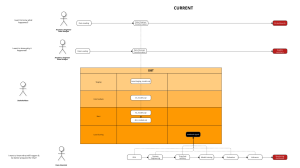What are Data Silos?
A data silo is a collection of data held by one group that is not easily or fully accessible by other groups. Data tends to be organized by internal departments. Finance, administration, HR, and other departments need different information to do their work, and those individual collections of often overlapping-but-inconsistent data are in separate silos. As the quantity and diversity of data grows, silos continue to grow too.
Data silos hinder the process of gleaning deep, actionable insights from organizational data, and create a barrier to a holistic view of company data. To harvest the full benefits of data analysis, organizations need a 360-degree view of their data in order to get an enterprise-wide view of hidden opportunities (or threats!).
To better understand if data silos are holding back your potential for holistic data analysis, you can learn more about data silos, how they hinder getting the full benefit of data, and what you can do to achieve data integration.

Where do data silos come from?
Data silos occur naturally over time and stem from conditions common to most businesses. As each department collects and stores its own data for its own purposes, it creates its own data silo.
Organizational structure
Before big data and the cloud revolutionized business, it wasn’t considered a bad thing for different departments to create and manage their own data. Each department has its own policies, procedures, and goals. Teams developed their own ways of working with and analyzing data in ways that suited their needs. Silos were built around company departments because that’s how the data was collected and stored.
Culture
Operations, HR, admissions, and other departments are accustomed to working in their own worlds. Each has its own lingo, processes, and challenges. They work in physically separate areas, so each department naturally considers itself separate from the others. This culture of separation ties over to data. Since company-wide data sharing is a relatively new goal, departments haven’t been motivated to share.
Technology
Departments tend to support their operations using different technology solutions and tools, such as spreadsheets, accounting software, or hospital management software. Each solution stores and manages data in different ways — many of which are proprietary to the vendor that created the solution. Legacy systems were not designed to easily share data. So the tech tools many organizations use every day have pushed them into data silos by the proprietary nature of their data management processes.

4 ways data silos are silently tearing down the organization
Each department exists to support a common goal. While departments operate separately, they are also interdependent. At least some of the data that the finance department creates and manages, for example, is relevant for analysis by administration and other departments.
Competition, the need to cut costs, and the desire to seize opportunities are driving organizations to do more with their data. Access to enterprise-wide information is necessary to maximize operational efficiencies and discover new opportunities.
But at some point, data silos will pose a barrier to success. Here are four common ways that can happen:
1. Data silos limit the view of data
Silos prevent relevant data from being shared. Each department’s analysis is limited by its own view. Discovering enterprise-wide efficiencies can’t happen without an enterprise-wide view of data. How can you find hidden opportunities for operational cost savings, for example, if operations and cost data aren’t consolidated?
2. Data silos threaten data integrity
When data is siloed, the same information is often stored in different databases, leading to inconsistencies between departmental data. As data ages, it can become less accurate, and therefore, less useful. For example, if data on the same patient is stored in different systems, this data can become out of sync over time.
3. Data silos waste resources
When the same information is stored in different places, and when users download data into their personal or group storage, resources suffer. Streamlining data into one source frees up precious storage and relieves IT stress in buying and maintaining storage that may not be needed. For example, many workers download data to analyze in a spreadsheet, and each download is a redundant copy of existing data.
4. Data silos discourage collaborative work
Culture creates silos, and silos reinforce culture. Data-driven organizations are embracing collaboration as a powerful tool to find and leverage new insights. In order to encourage collaboration, departments need a way to share their data. When data is difficult or impossible to share, the ability to collaborate suffers.
How to break down data silos
Centralizing data for analysis has become much faster and easier in the cloud. What took weeks, months, or years can now be accomplished in days or hours with tools that streamline the process of gathering data into a common pool and format for efficient analysis. The solutions to silos are technological and organizational.
Change the culture
Communicate the benefits of data sharing so that workers understand the shift. Also communicate the problems with silos, including data integrity and the inability to be competitive. Culture change is a challenge, so management must show commitment.
Develop a way to centralize data
The best way to bust silos is to pool data into a cloud-based data warehouse or data lake — central data repositories optimized for efficient analysis. Data from disparate sources are homogenized and consolidated, and access can be easily granted to individuals or groups.
Integrate data
Integrating data efficiently and accurately is a guaranteed method to preventing future data silos. Organizations integrate data using different methods.
- What the heck is data analytics? Explain it like I’m five. - June 8, 2022
- Best Practices for Managing Data Access to BigQuery - October 11, 2021
- How PE firms can turn data science into a competitive advantage - October 11, 2021



